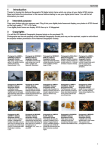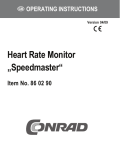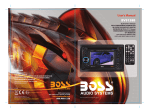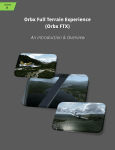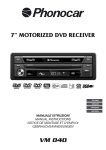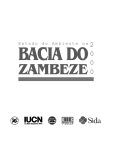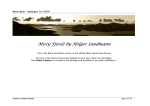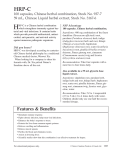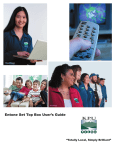Download Topcom NG8060 User's Manual
Transcript
NG8060 1 Introduction 2 Features 2.1 • • • • • • • Photo album Copy your photos onto your memory card. Plug it into your digital photo frame and display your photos in JPEG format on the high quality 8" TFT LCD Panel. Display JPEG files up to 12 Mega pixel. Digital photos in the memory cards, USB stick or Built in memory will be directly displayed. Rotate photos 360 degrees and zoom in. Transfer photos from your computer to digital photo frame with a USB cable. Listen to music files during the photo slide show. Send photos from your mobile phone using Bluetooth and display them directly on the screen. 2.2 • • Music album Listen to music files stored in the internal memory, on a memory card or USB stick on the build in speakers. Control the sound with the enclosed remote control. 2.3 • • Video album Display MPG videos stored in the internal memory, on a memory card or USB stick. Controlled the video and audio with the enclosed remote control. 3 • • • • • • • • • • • • • • ENGLISH Thanks for buying this National GeographicTM digital photo frame which can show all your digital JPEG photos, play your music files and show your videos. Read and follow the instructions in this manual before starting to use your digital photo frame. You will find all information you need. Safety precaution and maintenance Read and follow these instructions before using your digital photo frame. Keep this user manual for future reference. This product is not a toy, it contains fragile and swallowable glass parts and small parts. Do not permit children to play with it. The product is intended for private use only. The LCD panel of digital photo frame is made of glass and fragile, so it is sensitive to abnormal force. Please do not put excessive pressure on the LCD Panel. Please be careful while cleaning, handling and keep it away from sharp edges. Unplug your digital photo frame if you are not going to use it for an extensive period of time. Your digital photo frame is a complicated electronic device and can be damaged from being dropped. Keep your digital photo frame dry. Exposing to liquid or moisture will damage your digital photo frame. To avoid the risk of electric shock, do not expose it to rain or excessive moisture. Use only dry and soft cloth for cleaning LCD panel. Be sure that your photo frame is shut down when plugging in and out a memory card. Keep your digital photo frame out of direct sunlight, stoves or any other heat source. The back cabinet of your digital photo frame should only be opened by authorized service technicians. Never open it by yourself. Be sure the stand of your digital photo frame is clear from cables to avoid that your digital photo frame is pulled to the floor. Dangerous voltages are present inside the unit. Never open the housing or insert objects through the ventilation holes. 4 Gift box content – – – – – – – – Digital Photo Frame AC-DC Adaptor Frame Stand Quick User Guide Warranty Card Mini USB (male) to regular USB (female) convertor cable USB cable Support & Content CD (National Geographic Licensed Photos & Full User Manuals) 1 NG8060 5 Copyrights You will find 20 National Geographic licensed photo on the enclosed CD. Photographs are the sole property of the National Geographic Society and may not be reprinted, copied or sold without the express written permission of the National Geographic Society. Photograph by JAMES L. STANFIELD / National Geographic Society Mute swans (Cygnus olor) gather in the grassy marshes of Nantucket Sound, Massachusetts, U.S.A. Photograph by GEORGE F. MOBLEY/ National Geographic Society A dandelion bursts through early spring snow cover to bask in sunlight near Appenzell, Switzerland. Photograph by GEORGE F. MOBLEY / National Geographic Society High in the Andes Mountains, sunlight illuminates the peaks of the Cordillera de Paine range in Chile. Photograph by PAUL ZAHL / National Geographic Society A goldfish (Carassius auratus ) sporting bulging eye sockets swims by — a surreal reminder of nature’s diversity. Photograph by JAMES L. STANFIELD / National Geographic Society A plains zebra (Equus burchelli ) keeps close watch over her young foal in Hwange National Park, Zimbabwe. Photograph by MICHAEL NICHOLS / National Geographic Society A humpback whale (Megaptera novaeangliae) crashes back into the water after breaching off the coast of Gabon’s Loango National Park. Photograph by CHRIS JOHNS / National Geographic Society On a wild plain in Africa, a strikingly beautiful cheetah (Acinonyx jubatus) gazes intently beyond the frame of a photographer’s scope. Photograph by JAMES L. STANFIELD / National Geographic Society A ghost crab (Ocypode) in a defensive posture reacts to an intruder’s approach along a beach on Samana Cay, Bahamas. Photograph by JAMES L. STANFIELD / National Geographic Society The Monumental Arch and Great Colonnade in Palmyra, Syria, stand silent testament to the ancient cultures that once thrived here. Photograph by JOHN SCOFIELD / National Geographic Society Awash in hues of green and blue, a normally brooding Venice shines brightly in the midday sun. Photograph by W.E. GARRETT / National Geographic Society Awash in beams of golden sunlight, a waterfall from Havasu Creek falls over and down red rock forming part of the southern rim of the Grand Canyon on Havasupai Indian Reservation in Arizona, U.S.A. Photograph by MICHAEL NICHOLS / National Geographic Society Giant panda cub (Ailuropoda melanoleuca) Tai Shan plays with his mother, Mei Xiang. Tai Shan was born in captivity at the National Zoo in Washington, D.C., U.S.A., in July 2005. Photograph by JAMES P. BLAIR / National Geographic Society Time stands still along the shoreline of Walker Cove in Alaska’s Tongass National Forest. Subsidised logging is destroying much of the oldgrowth rain forest found in this prized American woodland region. Photograph by RAYMOND GEHMAN / National Geographic Society Fallen aspen leaves lay scattered across fresh snowfall near Moraine Lake in Canada’s Banff National Park. Photography b MICHAEL NICHOLS / National Geographic Society A beautiful wild orchid stretches like a yoga master. This specimen was photographed in Gabon. Photograph by JODI COBB / National Geographic Society Viewed from the Bund, the city of Shanghai’s rapid modernization is powerfully illustrated. The city has long been China’s cultural capital, but thanks to recent financial success, it is now experiencing whirlwind growth. Photograph by JAMES P. BLAIR / National Geographic Society First a seat of power for the Byzantine Empire and then converted to an imperial mosque by a conquering sultan, the glorious, centuriesold Hagia Sophia is now a museum and World Heritage site in Istanbul, Turkey . Photograph by MICHAEL NICHOLS / National Geographic Society Two young male forest elephants (Loxodonta cyclotis ) kick up muddy water as they spar. These animals struggle to survive a constant onslaught from poachers even within the protected confines of Gabon’s Ivindo National Park. Photograph by GEORGE F. MOBLEY / National Geographic Society A solitary canoer paddles across the glassy surface of Lake Schrader in Alaska’s Arctic National Wildlife Refuge, an area under constant threat of habitat degradation from oil developers and other industries wanting a piece of its rich natural resources. Photograph by DEAN CONGER / National Geographic Society Iconic buildings shrouded in shadows line Red Square in Moscow under a still, night sky. The square is rich with Russian history, paying homage to the many empires that rose and fell within its unblinking gaze. 2 NG8060 6.1 Description ENGLISH 6 Front panel 1. Removable frame 2. Remote control receiver 3. LCD - display 1 6.2 Back side 4. Stand 5. Removable frame lock 6. Escape button 7. Enter button 8. Speaker 9. Navigation button 10. Power indicator LED 11. Power Switch 6.3 2 4 3 5 6 7 8 9 10 11 © 2008 National Geographic Society Bottom 12. Mini USB - port 13. DC power jack (+5V DC) 14. CF card slot 15. SD/MMC/MS PRO - card slot 12 6.4 13 15 14 Remote control 16. Navigation buttons 17. Enter 18. Mute 19. Rotate picture clockwise 20. Info 21. Volume down 22. Volume up 23. Zoom button 24. Mode button 25. Escape 26. Rotate picture counter clockwise 26 16 17 25 18 24 23 19 22 21 20 3 NG8060 7 7.1 Installation Desktop placement Install the enclosed stand 4 at the back of the digital photo frame (horizontal or vertical). 7.2 Power adapter connector Only use the power adapter supplied (DC +5 V, 1,8 A). Do not use other adapters, as this may damage the device. The wall outlet for the power supply must be close and easy accessible. • Connect the small plug of the AC adaptor to the photo frame adapter Jack 13 and the other end of the adapter cable to the electric socket (230V/50Hz). 8 Plugging in memory card Your digital photo frame can work with these memory cards: • Memory slot 14 – Secure Digital (SD-TM) – Multi Media (MMC-TM) – Memory StickTM & Memory Stick ProTM • Memory slot 15 – Compact Flash (CF) • Memory slot 12 – USB Flash Memory Insert the memory card into the relevant slot on the digital photo frame. Be sure that the memory card is in the right direction. To connect a USB Flash Memory stick, first connect the Mini USB (male) to regular USB (female) convertor cable into the Mini USB - port. 9 Menu navigation At the backside of the unit, as well as on the remote control, you will find the ‘Enter’ 7 / 17 , ‘Esc’ button 6 / 25 (Escape) and the navigation buttons (arrows) 9 / 16 . The function on both remote and unit are the same. • Press ‘Enter’ 7 / 17 to confirm a selected item or enter a sub menu. • Press ‘ESC’ 6 / 25 to leave a menu or setting. • The next navigation buttons 9 / 16 can be used to navigate through the menu: 16 Up button • • • • • Down button Left button Right button 4 • • • Move the cursor up in the menu. Open brightness adjustment menu at playing mode. Switch picture control bar and music control bar (After use button "ENTER" open the control bar in Image mode). Shift up when zooming in a picture. Page up at the first line of the 9-pictures thumbnail. • • Move the cursor down in the menu. Open volume adjustment menu at playing interface. Switch picture control bar and music control bar (After "ENTER" button open control bar). Shift down when zooming in a picture. Page down at the last line of the 9-pictures thumbnail. • • • • • Move the cursor left at the menu. Back to the previous folder in file list. Jump to the previous file at playing interface. Shift left when zooming in a picture (only when the control bar is closed). Page up at the first picture of 9-picture thumbnail. • • • • • • Move right the cursor at the menu. Open the selected folder in file list. Active the copy/delete function for selected files. Jump to the next file at playing interface. Shift right when zooming in a picture (only when the control bar is closed). Page down at the last picture of 9-picture thumbnail. NG8060 10 Getting started (Preset mode) 11 11.1 A. B. C. D. E. 11.2 Functions ENGLISH After connecting the AC/DC adaptor: • Set the Power Switch 11 to ‘ON’, to turn the power on. When there is no memory card installed, the clock and the calendar mode is displayed. • Set the Power Switch 11 to ‘ ’, to activate the frame lighting. • Press ‘Enter’ 17 to enter ‘Card select’ mode. • Install, if necessary, a memory card (see ‘8 Plugging in memory card’). • Select the memory card by using the navigation buttons and press ‘Enter’ 17 to enter the ‘Function select’ mode. The startup mode can be changed (see ‘11.6 Settings’). If you change the startup mode, the system will search files for the new setting. If the system can not find the files, ‘card select’ mode will appear on the screen. A B C D E ‘Function select mode’ display Image mode Music mode Video mode File mode Setup mode Displaying photos The photos can be displayed from the internal memory, a memory card or a USB Flash Memory. Only pictures in JPEG format can be displayed in your digital photo frame. When ‘Function select mode’ is displayed: • Press ‘Enter’ 17 when the cursor is on the ‘Image’ icon to display the thumbnail mode of the photos in your memory card. • Use navigation buttons 16 on the remote control to select the photo you want to display. • Press ‘Enter’ 17 to see the picture in full size. The slide show will start automatically. • Press 16 of the navigation buttons to display the previous photo. • Press 16 to display the next photo. • Press the rotate button 19 or 26 to rotate the picture clock or counter clockwise. • Press the zoom button 23 to zoom in. During zoom, press the navigation keys 16 to shift the picture. 11.2.1 Brightness • Press 16 to activate the brightness bar. • Press 16 or 16 to change the brightness. • Press ‘ESC’ 25 to remove the brightness bar. 11.2.2 Volume • Press 16 of the navigation buttons to activate the volume bar. • Press 16 or 16 to change the volume. • Press ‘ESC’ 25 to remove the volume bar. 5 NG8060 11.2.3 Control bar • Press ‘Enter’ 17 to display the control bar. • Use navigation buttons 16 on the remote control to select one of the icons. a. Status c d a b. Play/Pause c. Stop d. Rotate picture 90° e. Zoom f. Previous picture g. Next picture h. Show file info b i. View thumbnails 3 x 3 j. Picture resolution • Press ‘Enter’ 17 to activate the function. • Press ‘ESC’ 25 to remove the control bar. If no button is pressed, the control bar will automatically disappear in 10 seconds. 11.3 e f i j g i h j k j k Watching video When ‘Function select mode’ is displayed: • Press ‘Enter’ 17 when the cursor is on the ‘Video’ icon. The first video will play automatically. • Press the volume up button 22 to increase the volume. • Press the volume down button 21 to decrease the volume. • Press ‘Enter’ 17 to display the control bar. Use navigation buttons 16 on the remote control to select one of the icons. a. Status b. Play time d e f c. Play/Pause d. Stop e. Previous video f. Fast backward g. Fast forward h. Next video c a b i. Show file info j. Zoom k. Play mode • Press ‘Enter’ 17 to activate the function. • Press ‘ESC’ 25 to remove the control bar. If no button is pressed, the control bar will automatically disappear in 10 seconds. 6 g Listening to music When ‘Function select mode’ is displayed: • Press ‘Enter’ 17 when the cursor is on the ‘Music’ icon. The first song will play automatically. • Press the volume up button 22 to increase the volume. • Press the volume down button 21 to decrease the volume. • Press ‘Enter’ 17 to display the control bar. • Use navigation buttons 16 on the remote control to select one of the icons. a. Status b. Play time d e f c. Play/Pause d. Stop e. Previous song f. Fast backward g. Fast forward h. Next song c a b i. Show file info j. ID3 Tag k. Play mode • Press ‘Enter’ 17 to activate the function. • Press ‘ESC’ 25 to remove the control bar. If no button is pressed, the control bar will automatically disappear in 10 seconds. 11.4 h g i h NG8060 11.5 File manager ENGLISH When ‘Function select mode’ is displayed: • Press ‘Enter’ 17 when the cursor is on the ‘FILE’ icon. • Use navigation buttons 16 to move through the directories: – / 16 to scroll through the directory – 16 to enter the directory – 16 to exit the directory • Select the target file and press will appear on the left of the 16 . A sign selected file's name. • To unselect the file press 16 again. You can select more that one files with the previous step. • Press the info button 19 to open the action menu. To delete the selected files: • Press 16 to select the 'Trash' icon. • Press ‘Enter’ 17 to confirm. • To turn back to the file menu, press ‘Enter’ 17 again. • Exit the current folder by pressing 16 or ‘ESC’ 25 To copy the selected files when the action menu is displayed: • Exit the current folder by pressing 16 or ‘ESC’ 25 and enter to the target folder. • Press ‘Info’ 19 and move the cursor on to the 'Copy' icon by 16 . • Press ‘Enter’ 17 to copy the selected files to the target folder. • Press ‘Enter’ 17 again to turn back to the file menu. 11.6 Settings • Select the ‘Setup’ icon by using the navigation buttons 16 in the ‘Function select mode’. • Press ‘Enter’ 17 , the setup menu is displayed. Select on of the next settings by using the navigation buttons and press ‘Enter’ 17 : 1. Language Setting – Select the desired language (English, German, French, Italian, Spanish, Dutch, Portuguese and Turkish) and press ‘Enter’ 17 . 2. Picture Setting. – Use navigation buttons to select ‘Slideshow Model’ or ‘Picture Play Mode’ and press ‘Enter’ 17 . – Select one of the settings and press ‘Enter’ 17 to confirm. 3. Clock setting – Use 16 or 16 to move the cursor on date and clock. – Use and 16 to change the date and the clock. 4. Alarm setting – Move the cursor with or 16 to select the item to be set (hour/date/number of rings and mode). – Change the settings with and 16 . There are three rings. The mode can be set as OFF/once/day. 5. Start up mode – Use and 16 to select the start up mode (Calendar/ Picture/Music/Movie/Picture+Music). 6. Video Setting: – Use and 16 to select Brightness, Contrast or Saturation. – Use 16 or 16 to change the value (0 to 16). 7. Bluetooth Setting: – Press ‘Enter’ 17 to open the bluetooth setting menu. – Use and 16 to select ‘ON’ or ‘OFF’ 8. Default Setting: – Press ‘Enter’ 17 to reset the digital photo frame to the factory setup. 9. Version – Press ‘Enter’ 17 to see the software version. 7 NG8060 12 PC connection The digital photo frame can be connected to a computer to act as a card reader for file transfer from your computer's hard drive to the internal memory, the installed memory cards or USB stick. 12.1 Windows® Vista™/XP/XP Pro/2000 SP3 users No drivers are needed for Windows Vista, XP, XP Pro, Windows 2000 SP3. Your computer will recognize the digital photo frame upon connection of the USB cable. 12.2 USB connection to computer To connect the digital photo frame to your computer, you will need a standard USB cable, Type A Male to Type Mini B 5-pin Male (The USB cable is not included). • Set the Power Switch 11 to ‘ON’, to turn the power on. • Press ‘Enter’ 17 to enter 'card select' mode. • Connect the small end of the USB cable to the mini USB port 12 on the bottom of the digital photo frame. • Connect the larger end of the USB cable to a USB port on your computer. • The digital photo frame will display ‘Connecting PC’. • Five drive letters entitled ‘Removable Disc’ will appear under the ‘My Computer’ icon in Windows; one for each of the memory card slots and internal memory on the digital photo frame ‘Nand’. • For files transfer, double-click the appropriate ‘Removable Disc’ icon to access for files copy and delete amongst your computer, digital photo frame internal memory and all installed memory cards. 12.3 • • • • • 13 Disconnect the digital photo frame from your computer In the Windows task bar, right click the icon "Safely Remove Hardware". The ‘Safely Remove Hardware’ dialogue box will appear. Select "USB Mass Storage Device" and click ‘STOP’. On the next dialogue box, click ‘OK’ to remove the storage device. On the final dialogue box, select ‘CLOSE’ and disconnect the USB cable from your computer. The digital frame must be re-started. Bluetooth communication Files can be transferred from other built in Bluetooth devices such as mobile phones, PDA, PC etc. to NG8060. The built-in Bluetooth module works at the mode ‘OPP (Object Pull Profile)’, so NG8060 just can receive files by Bluetooth. • • • • • • • • Set the Power Switch 11 to ‘ON’, to turn the power on. Press ‘Enter’ 17 to enter 'card select' mode. If the icon of Bluetooth is highlight, it shows the module is active. If the icon is white, go to the settings menu and under Bluetooth settings make it ‘ON’. Turn on your Bluetooth function of your device (mobile phone, PDA, PC etc.) and start searching. The Bluetooth name of your photo frame is ‘NG8060’, after finding it, pair the devices (it will ask a password, pls input "0000"). When the devices are paired, the files can be transmitted. After the transfer is finished, the picture is saved in the memory which was selected in the card select menu (if it is Nand Flash, it will be saved in that internal memory) and displayed on the screen automatically. During transmission, the rate will be shown on the screen. If you would like to cancel it, press ‘Enter’ 7 . The maximum distance of the Bluetooth communication is 10m. The name of files for transmitting must be Turkish, English, French, German, Italian, Spanish, Dutch or Portuguese. A number, including some other characters will be transmitted. When the transmission has failed, restart the product to use the Bluetooth again. If the memory card is full or could not receive files, please match the two equipments over again. 8 NG8060 Technical specifications Screen – – – – – – – – Screen Size Screen Display Size Resolution Dot gap Brightness Screen Mode: Life cycle of the LCD screen Display language 8 inch 158 X 99 mm 800 X 480 Horizontal 0,107 mm; vertical 0,37 mm 300 cd/m2 16:9 20.000 hours English/Turkish/German/French/Spanish/Italian/ Dutch/Portugues Photo – – – – – Photo File Format: Maximum Photo Size Slide Show Interval Photo Edit Settings JPEG 12 Mega pixel Fast / Normal / Slow Copy, Delete, Rotate, Pause, Zoom Brightness, contrast, saturation Connections – Memory Card Slot – USB Connection – Build in memory – Built in Bluetooth SD/MMC/MS 1 128 MB Yes Music – – – Music File Format : Background Music During Slide Show Built in Speaker : MP3 / WMA Yes Yes Video – Video formats Mpeg1 / Mpeg2 / Mpeg4 / Mjpeg Others – – – – – Dimensions Weight Power Consumption Operating Temperature Storage Temperature 246 x 178 x 85 mm.(With frame stand) 0.680 kg 7,5 W 0 °C ~ 40 °C -20 °C ~ 60 °C 15 ENGLISH 14 Cleaning the device To clean the device, wipe with a soft cloth dampened with water. To clean dirty joints, use a non-scratching brush. Don’t use a cleaner or solvents on the unit. They can damage the case and leak inside, causing permanent damage. 16 Disposal of the device (environment) At the end of the product lifecycle, you should not throw this product into the normal household garbage but bring the product to a collection point for the recycling of electrical and electronic equipments. The symbol on the product, user guide and/or box indicate this. Some of the product materials can be re-used if you bring them to a recycling point. By re-using some parts or raw materials from used products you make an important contribution to the protection of the environment. Please contact your local authorities in case you need more information on the collection points in your area. 9 NG8060 17 17.1 Warranty Warranty period The devices have a 24-month warranty period. The warranty period starts on the day the new unit is purchased. Consumables or defects causing a negligible effect on operation or value of the equipment are not covered. The warranty has to be proven by presentation of the original or copy of the purchase receipt, on which the date of purchase and the unit-model are indicated. 17.2 Warranty handling A faulty unit needs to be returned to an authorized service centre including a valid purchase note and a filled in service card. If the unit develops a fault during the warranty period, the service centre will repair any defects caused by material or manufacturing faults free of charge, by either repairing or exchanging the faulty units or parts of the faulty units. In case of replacement, colour and model can be different from the original purchased unit. The initial purchase date shall determine the start of the warranty period. The warranty period is not extended if the unit is exchanged or repaired by the service centre. 17.3 Warranty exclusions Damage or defects caused by incorrect treatment or operation and damage resulting from use of non-original parts or accessories are not covered by the warranty. The warranty does not cover damage caused by outside factors, such as lightning, water and fire, nor any damage caused during transportation. No warranty can be claimed if the serial number on the units has been changed, removed or rendered illegible. Any warranty claims will be invalid if the unit has been repaired, altered or modified by the buyer. 17.4 TFT-LCD defect policy Despite the highest possible standards, the intricate manufacturing of thin-film transistor ( TFT) liquid crystal display (LCD) screens may still produce slight visual imperfections. However, there will be provided a warranty service for your NG8060's TFT LCD screen if there are : – 3 bright dots or 5 dark dots or 8 bright and/or dark dots in total; or – 2 adjacent bright dots or 2 adjacent dark dots; or – 3 bright and/or dark dots inside an area of 15mm diameter These TFT LCD screen warranty conditions are offered by theTFT LCD manufacturers. Therefore, at its option, the product will be repaired or replaced. . A bright dot is a white or sub-pixel that is always on. A dark dot is a black or sub-pixel that is always off. This product is in compliance with the essential requirements and other relevant provisions of the directive 2004/108/EC. 10











